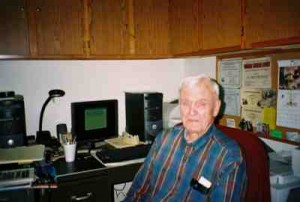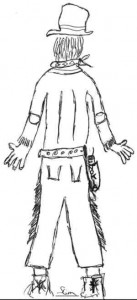Brief by Ed Quillen
Regional News – September 2005 – Colorado Central Magazine
Feast or Famine
Our weather seems to mimic the Colorado economy: Boom and Bust. We complain about how little rain we get, and then suddenly there’s too much.
That happened on Aug. 5 about 10 miles northeast of Salida, when a thunderstorm dropped 1.6 inches of rain in about 30 minutes. The water from a 35-square-mile drainage roared down Dead Horse Gulch, washing out a private road that served more than a dozen residences. It also washed out Spiral Drive, the road that leads to the top of Tenderfoot Hill.
Gunnison County got its gully-washer on Aug. 4, when “it was just raining buckets for about 30 minutes” in the Jack’s Cabin area near Almont. Water rushed across the Jack’s Cabin Cut-off Road in three places, and Colo. 135 had more than a foot of water pouring across it, carrying small logs and old tires. Some area wells might have been contaminated by the flood, so the county asked about 40 residents in the affected area to get their water tested for coliform bacteria.
A fitting disguise
Cell phones are a fixture of modern America, and so are their towers. But there are places where modern America doesn’t fit, such as the east side of Leadville, home to scores of old mines.
San Isabel Telecom wanted its tower to fit in, so it was designed to look like a mine headframe, complete with a bullwheel at the top. The tower will also provide wireless Internet access.
The Lake County Planning Commission approved the proposal, and so did the county commissioners. We like the idea of blending in, and we’re looking forward to new structures that look like coal tipples, water tanks, and windmills in Central Colorado.
You can’t get there from here
Gasoline prices are at record levels and lots of people are talking about conserving energy.
But don’t try to conserve by using scheduled public transportation around here. There isn’t any — or at least, there is no longer any Greyhound bus service on U.S. 50 between Pueblo and Grand Junction, which means none for Cañon City, Salida, and Gunnison.
The last day of service was Aug. 17. Greyhound was operated in this area by the Texas, New Mexico & Oklahoma bus line. The company’s general manager said that the elimination of service here was “essential to our ability to meet the needs of our customers.” We didn’t make that up.
According to the Salida Mountain Mail, Salida averaged half a dozen daily arrivals and departures, and the Department of Corrections used the bus to send inmates home after their sentences were completed. Will they be hitch-hiking henceforth?
Just what did they mine in Vail?
The July 28 Leadville Herald-Democrat reported on a meeting where Bill Lyle of the Resurrection Mining Co. spoke: “‘Recreation places are thriving on the infrastructure built by mining.’ He mentioned Vail and Aspen as examples. They use the electricity, sewer and water systems put in for the early mining industry.”
But we wonder just when the mining industry built any infrastructure in Vail, which was founded as a ski resort in 1962.
Open and Shut
If you want to swim indoors, the Salida Hot Springs Pool has been open more or less continuously for more than a year now, which might be some kind of record.
Leadville’s pool got two new boilers, and it re-opened on Aug. 10. But in Bailey, the Marge E. Hudak swimming pool was scheduled for closure on Sept. 1 because the Platte Canyon School District didn’t have enough money to run it.
The pool costs about $70,000 a year to run, and brought in only $26,000 in revenues. The school district will put a tax question on the November ballot, and if it passes, the pool will re-open. A similar measure failed at the polls two years ago. It will be tough this time, Superintendent James Walpole said. “People just don’t want to pay more taxes and we can’t really campaign for it.”
New signals
Central Colorado is a land of few stoplights. We generally like it that way, although the summer traffic at Johnson Village, where the highway comes down Trout Creek Pass to split between southbound U.S. 285 and northbound U.S. 24, can be worse than annoying on busy summer weekends. The westbound traffic backs up as people wait to turn left if they’re headed for Salida, Poncha, or the San Luis Valley.
In July, Rick Routh, an engineer with the Colorado Department of Transportation told the Buena Vista town board that his agency plans to install a traffic signal at that intersection before the end of 2006.
Also scheduled for 2006 is a new stoplight for the intersection of Main and Highway 24 in Buena Vista. It will have dedicated left-turn arrows, perhaps in all four directions.
Bear gets death sentence
On July 19, a 14-year-old Texas boy was attacked by a bear inside his tent at Cutty’s Resort, a private campground above Coaldale. He fought off the bear, and suffered a bite on one hand, as well as some scratches and bruises.
Two days later, the bear returned. A medium-size older male, it was trapped and then killed by the Colorado Division of Wildlife. State policy dictates that course if a bear has attacked people before. First offenders, if caught, are relocated in the hope that they’ll avoid people.
The DOW reminds us that during this time of year, bears are consuming up to 20,000 calories a day as they stock up for their winter rest. In other words, they’re hungry, so don’t leave food around where they can get it.
But if you’re thirsty?
You can’t get it now, but one of these days, you might be able to pick up a bottle of Fairplay Water. The town clerk there, Mindy Cahill, got the town board’s permission to look into a water bottling plant for the town.
The idea came from Bryce Canyon, Utah, she said. The town started a bottling works for local water to raise money for revitalization. It worked so well that the plant was sold to a private company which continues the operation.
Fairplay could use the money and jobs, and it could also publicize the place and help with tourist marketing. And given how much Denver and other Front Range cities like South Park water, it could go over pretty well.
Fighting terrorism
Far be it from us to suggest that Custer County might not be of sufficient population or prominence to be a major target for terrorists.
It is, however, getting an $18,000 federal grant to improve Geographic Information Service mapping of telephones in the county, so that emergency responders, like the ambulance and sheriff’s deputies, can act more quickly on 911 calls.
That should be worthy in and of itself. But the grant proposal was pitched as a “bioterrorism/emergency preparedness project.” Somebody there knew how to phrase things to suit the current political environment. When we get around to fixing our sidewalk, perhaps we’ll apply for a “pedestrian emergency anti-terrorism responder facility grant.”
Overloaded road
Colorado Highway 114 connects Saguache to Gunnison via North Cochetopa Pass (our preferred term for what is also called North Pass). It’s a pretty drive, especially during aspen season, and it’s paved.
It’s also narrow and winding, and that has some Gunnison County residents worried because the highway attracts semi-trucks. At a hearing before the county commissioners in August, one resident said such traffic has been growing, and the “truckers drive too fast. The road has no shoulder, so if you make a little mistake, it can cause a rollover.”
According to the Colorado Department of Transportation, there have been 13 truck wrecks on that highway in the past six years, most of them rollovers. One truck dumped fertlizer into the creek, killing fish for miles, and last summer, a beer truck scattered its load.
Others at the hearing said that truckers know the highway is not patrolled regularly, so they speed and may run with overweight loads.
CDOT will put up some signs, work to improve some corners, and attempt to deploy portable scales on occasion.
Observations:
In the wake of a rockslide that closed I-70 for several days, a Denver TV station had this advice on its website: “According to CDOT, drivers should watch for rocks on the road when driving in Colorado’s high country.”
Well, duh. We submit that drivers should also watch for deer, elk, badgers, moose, cattle, sheep, horses, burros, coyotes, and washouts, among other things.
The Upper Gunnison River Water Conservancy District board was discussing a dam and reservoir on Tomichi Creek. “For what it would cost us to build the dam [$14 million], we could buy 90 percent of the land involved.”
Harley Tripp, quoted in the Gunnison Country Times, p. 24, July 21, 2005
Explaining why he attended a mountain man rendezvous in South Park in August, Randy Thomas said “These people overlook all my faults.”
p. 14, Fairplay Flume, Aug. 12, 2005
With three seats open on the Leadville City Council in the coming November election, one incumbent, Carol Hill, is not running again. Another, Scott Marcella, plans to run. The third is Caroline Puntenney who “was not sure if she would run. She said it depends on who puts in a petition. If someone really great is going to run, she doesn’t want to run against that person.”
p. 4, Leadville Herald-Democrat, Aug. 11, 2005
“Nobody who has become a resort town has re-opened a mine.”
Crested Butte Mayor Jim Schmidt, p. 4,
Gunnison Country Times, July 14, 2005
The Custer County government plans to ask taxpayers to increase the mill levy in November; the money will go to repair and improve county roads. As it is, county road superintendent Gary Havens said that “Pretty soon, we may just have to start tearing up the paved roads because we can’t maintain them.”
p. 1, Westcliffe Wet Mountain Tribune, Aug. 11, 2005
“What a sad day when a family member has to air their dirty laundry in a small-town newspaper. Maybe that’s how it’s done in Salida, but I was completely surprised to see it in our quaint little paper.”
Heidi Pacheco
in the Saguache Crescent, p. 1, July 21, 2005
“In a perfect world, high-altitude storage would be wonderful for everybody. But so would money growing in trees.”
John McClow, water attorney,
in the Gunnison Country Times, p. 25, Aug. 11, 2005.


